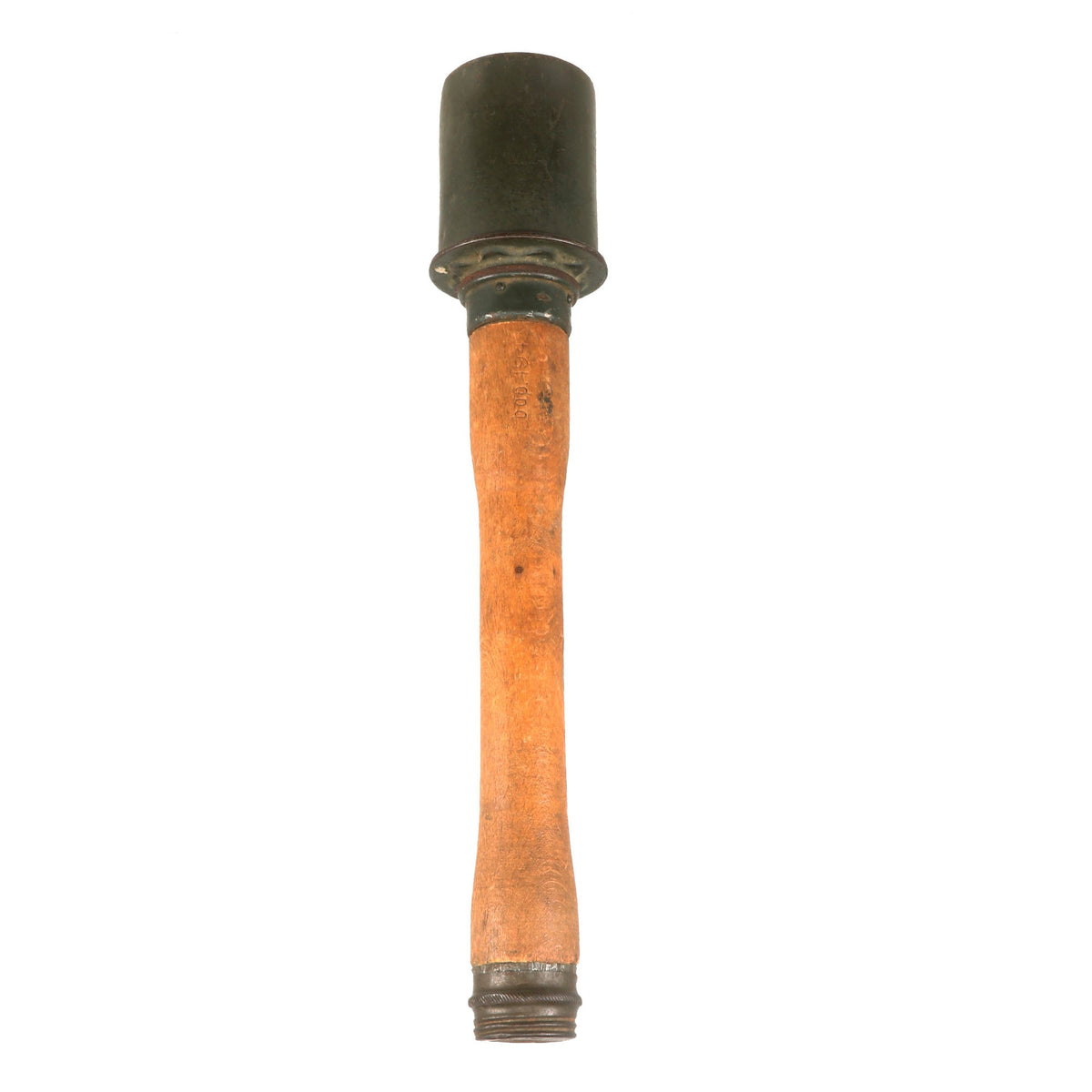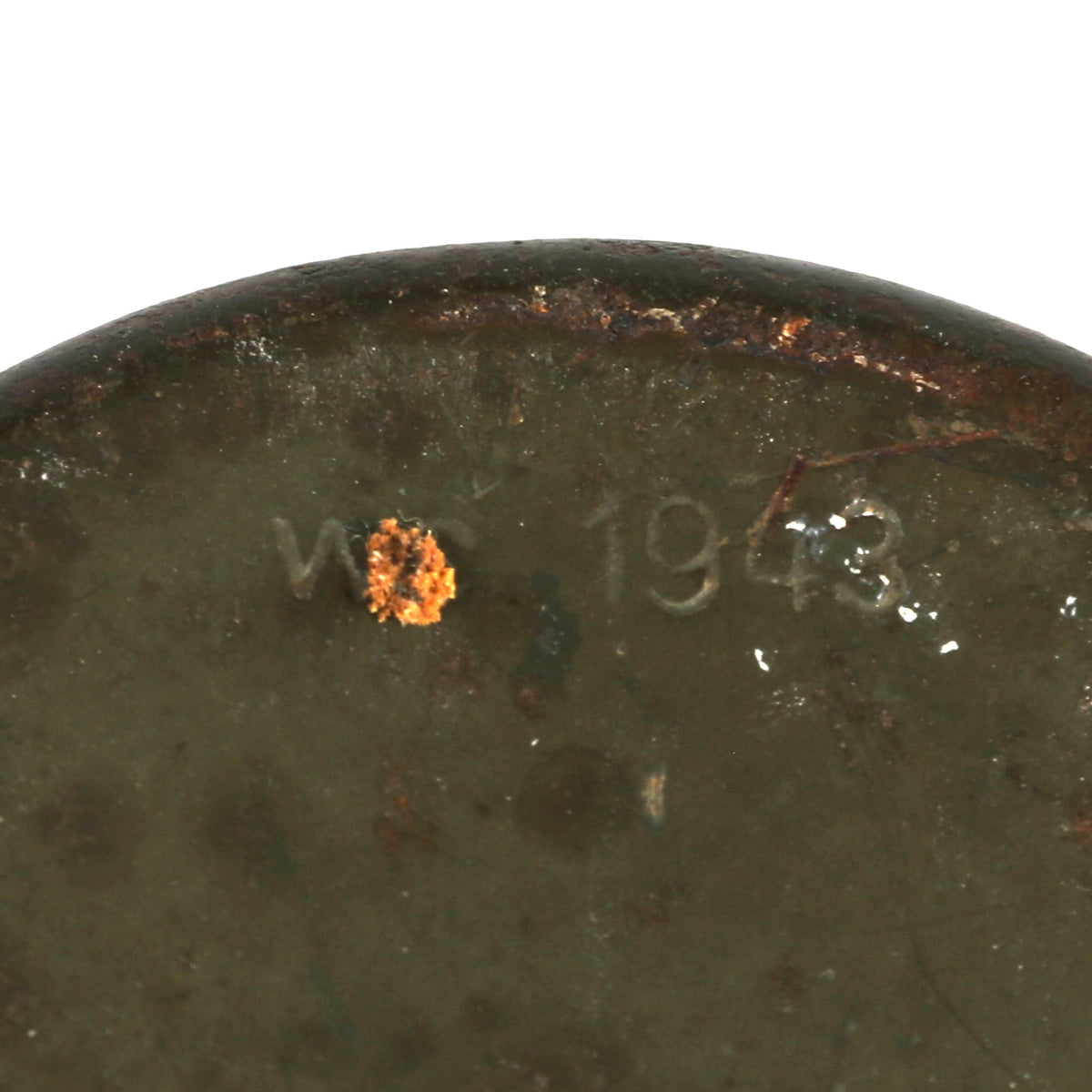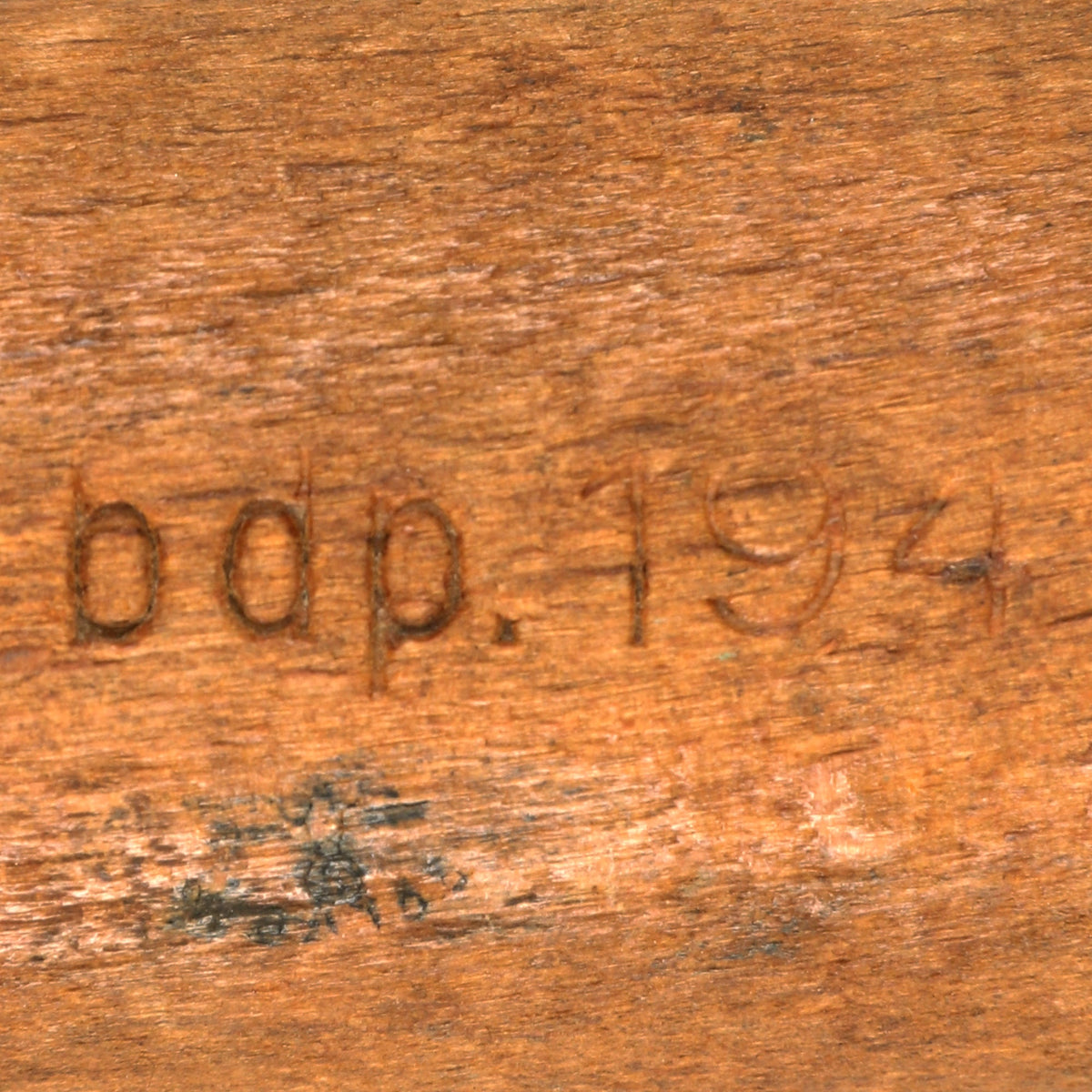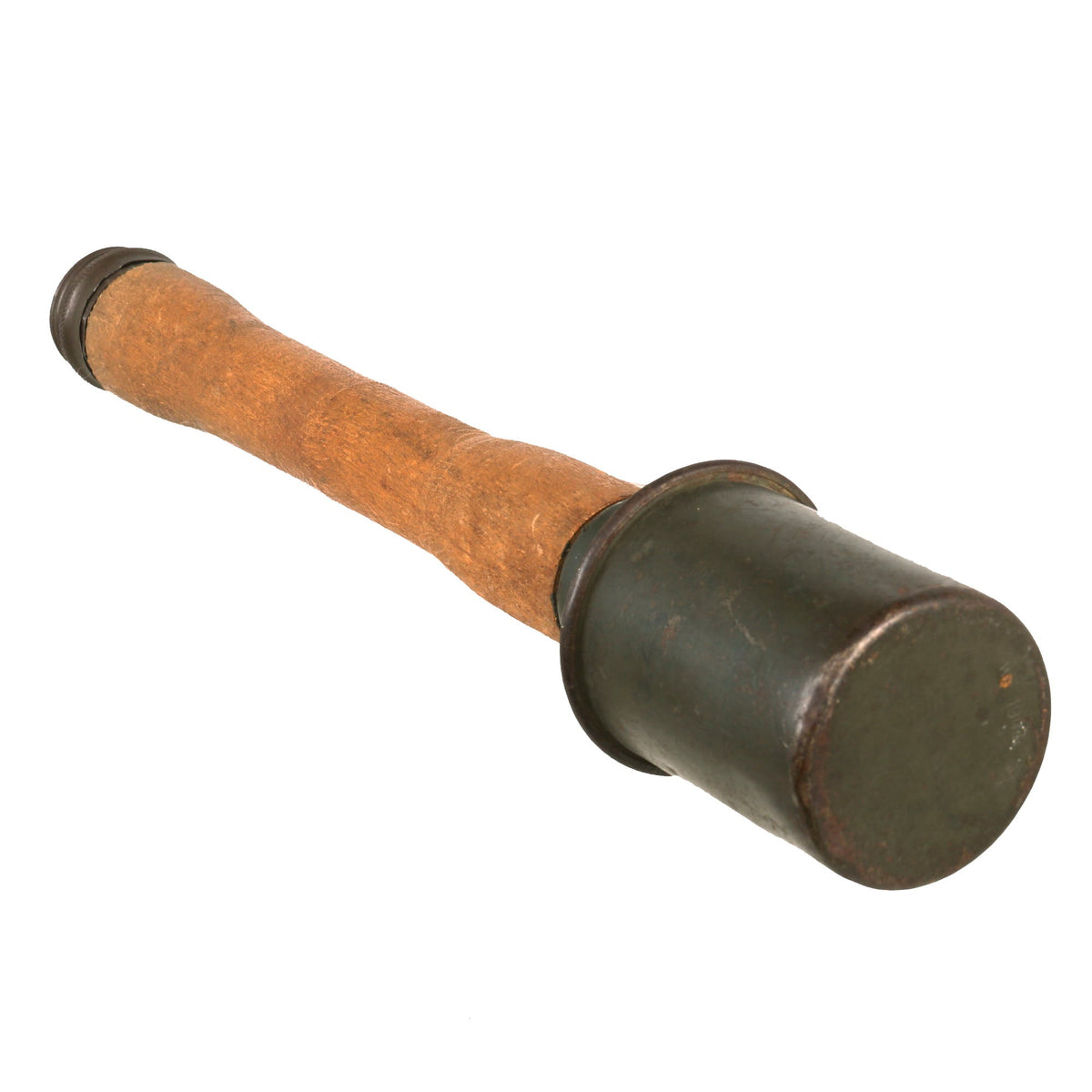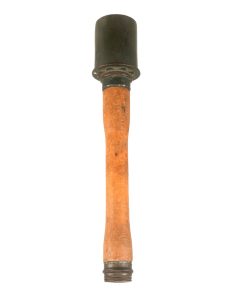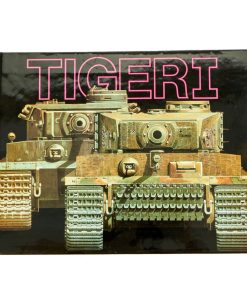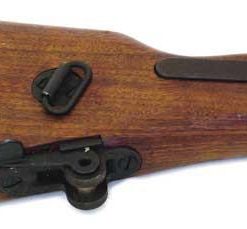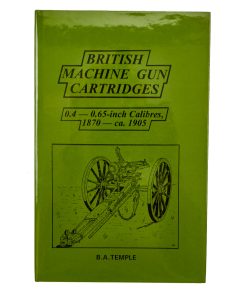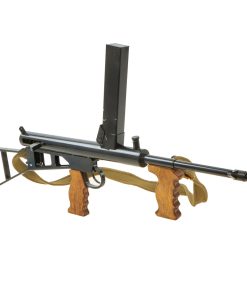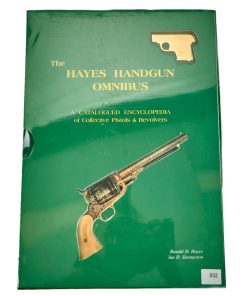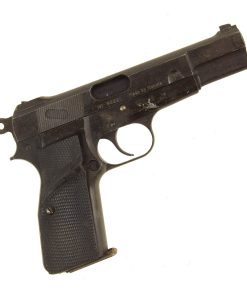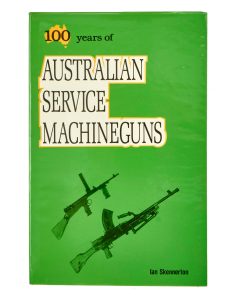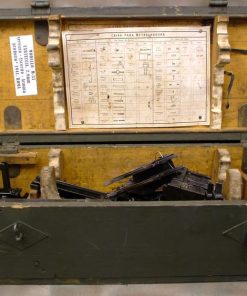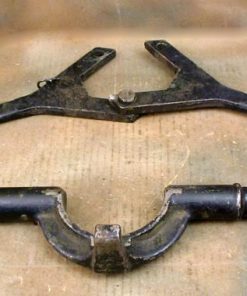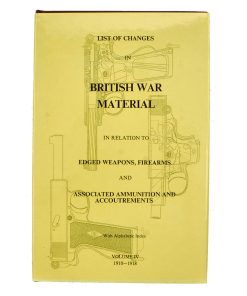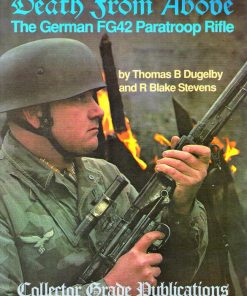Original German WWII M24 Inert Stick Grenade Stielhandgranate by Friedrich Maurer Söhne, Eisenwerk und Kesselschmiede – Dated 1943 Original Items
$ 1.295,00 $ 323,75
Original Item. Only One Available. This is a lovely example of a WWII German M-1924 German Stick Grenade. This very nice example has been demilitarized according to specifications by the BATF. It still retains its original paint and the original markings can be seen only on the head of the grenade. The interior even still retains the full pull cord with bead and weight. Like all deactivated ordnance, this grenade is not available for export.
The grenade is in overall great shape with few flaws. The bottom cap still unscrews and contains the full pull cord with bead and weight. The head of the grenade is marked wc 43 for Hasag, Hugo Schneider AG, Metalwarenfabrik Leipzig, werk Meuselwitz, Thuringia. The marking is very clear, and on the side of the body the stamp Do.3.43 is visible.
Metallwarenfabrik Hugo Schneider AG was founded in 1899. In the first years their main products were metal lamps and cookers. With the Great war they changed their production to ammunition components and other war materials. Post WW1 they resumed production of their civilian products, until the 1930’s again brought along the demand for military hardware. Their production increased until they in 1939 were the largest “war effort company” in Germany, which they remained until the end of the Reich. The HASAG company manufactured belt drums and belt drum holders for MG34 & 42, Panzerfausts, Panzerschrecks and ammunition components. The production line once again changed to civilian products after the end of the war. In 1947 all machinery and useful assets were removed to the Soviet Union and the buildings were blown up.
The shaft of the grenade is stamped bdp. 1943, for Friedrich Maurer Söhne, Eisenwerk und Kesselschmiede, München-Freimann. The code was followed by a punctuation to avoid confusion if it was turned upside down. The code used on the handle was stamped the opposite way of most other makers, running bottom-up. This makes the first letter fall on the curved area, almost always weakly impressed. In addition the WaA was placed between the code and the year on the 43 and 44 dated handles, unlike all other makers.
Founded in 1876 by Friedrich Maurer in Munich they initially manufactured steel constructions like bridges, hangars and steel doors. The company is still in operation, manufacturing, among other things, roller coasters.
Model 1924 (M24):
Upon the German Empire’s defeat at the conclusion of World War I, the collapse of industrial capability and military strength of Germany left many projects and ideas forgotten for years. When the newly created Weimar Republic progressively began to repair both the physical and economic devastation, a slow rebuilding of the armed forces was allowed under the limitations set by the allies.
The Weimar Republic revived the Stielhandgranate, and created a new version in 1924, the “Model 1924 Stielhandgranate” (M24). While retaining the same explosive and fuse, the main distinction between the M24 and the original M15 is a slightly shorter charge head and the removal of a belt carry clip. Another change in the design was a lengthening of the wooden handle. The intent of these design alterations was simply for mobility; German soldiers could easily (and often did) tuck the grenade in behind their uniform’s belt, held tight and secure. Being slightly lighter, and smaller in thickness, this improved overall use.
The M24 is well known as the standard hand grenade of the armed forces of the Wehrmacht during World War II. Adapting to the rapidly changing field of modern warfare, German soldiers would carry the M24 directly in front, allowing quick and easy access. However, in the later years of the war it was often advised to carry them in a different manner, as it was very likely any sort of explosion or heat could light the fuse from the grenade on the belt, resulting in unnecessary casualties.
The Model 24 Stielhandgranate was stored in specially designed crates during transport, which could carry up to 15 individual grenades. As a safety precaution, units of the Wehrmacht were advised to only insert the actual fuse assemblies when about to go into combat. Later in the war, however, many soldiers of the Wehrmacht would always have their weapons ready, due to the fierceness seen in the Soviet Red Army in the east and the progressive advance of the Allies on the Western Front. During production, a reminder was stenciled on each explosive charge: Vor Gebrauch Sprengkapsel einsetzen (“Before use insert detonator”).
The Model 1924 was rather ineffective by itself at damaging or disabling an enemy armored vehicle or destroying fortifications. It also lacked the shrapnel effect of most other grenades of the time. To overcome these faults, various German industries during World War II produced a number of variants that widened the utility and capability of the M244.
This is a fantastic example of a wartime manufactured M24 stick grenade, fully inert and ready to display.
Fast Shipping with Professional Packaging
Thanks to our longstanding association with UPS FedEx DHL, and other major international carriers, we are able to provide a range of shipping options. Our warehouse staff is expertly trained and will wrap your products according to our exact and precise specifications. Prior to shipping, your goods will be thoroughly examined and securely secured. We ship to thousands clients each day across multiple countries. This shows how we're dedicated to be the largest retailer on the internet. Warehouses and distribution centres can be located throughout Europe as well as the USA.
Note: Orders with more than one item will be assigned a processing date depending on the item.
Before shipping before shipping, we'll conduct a thorough inspection of the items you have ordered. Today, the majority of orders will be delivered within 48 hours. The delivery time will be between 3-7 days.
Returns
The stock is dynamic and we cannot completely manage it because multiple stakeholders are involved, including our factory and warehouse. So the actual stock may alter at any time. It's possible that you may not receive your order once the order has been made.
Our policy is valid for a period of 30 days. If you don't receive the product within 30 days, we are not able to issue a refund or an exchange.
You can only return an item if it is unused and in the same state as the day you received it. You must have the item in its original packaging.
Related products
Uncategorized
Uncategorized
Angolan Rebel 1970s era 60mm Inert Display Mortar from Angolan Civil War Original Items
Uncategorized
Uncategorized
Uncategorized
Australian WWII Owen MK1 Machine Carbine SMG Custom Fabricated Replica with Sling Original Items
Uncategorized
Uncategorized
Uncategorized
Uncategorized
Uncategorized
Uncategorized
Uncategorized
Uncategorized
Uncategorized
Uncategorized
Band of Brothers ORIGINAL GERMAN WWII Le. F.H. 18 10.5cm ARTILLERY PIECE Original Items
Uncategorized
Uncategorized
Uncategorized
